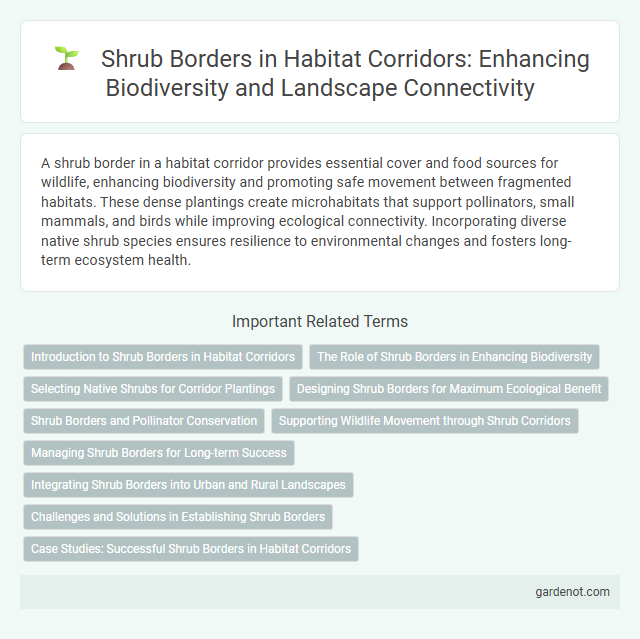A shrub border in a habitat corridor provides essential cover and food sources for wildlife, enhancing biodiversity and promoting safe movement between fragmented habitats. These dense plantings create microhabitats that support pollinators, small mammals, and birds while improving ecological connectivity. Incorporating diverse native shrub species ensures resilience to environmental changes and fosters long-term ecosystem health.
Introduction to Shrub Borders in Habitat Corridors
Shrub borders in habitat corridors create essential transitional zones that support biodiversity by offering shelter and food resources for various wildlife species. These dense plant layers improve connectivity between fragmented habitats, facilitating safe movement and gene flow among animal populations. Incorporating native shrub species enhances ecological resilience and promotes habitat heterogeneity within conservation landscapes.
The Role of Shrub Borders in Enhancing Biodiversity
Shrub borders serve as vital habitat corridors by providing shelter, foraging resources, and nesting sites that support diverse wildlife populations. These vegetative edges promote ecological connectivity, facilitating species movement and genetic exchange across fragmented landscapes. Their structural complexity enhances microhabitats, which increases overall biodiversity within both urban and rural ecosystems.
Selecting Native Shrubs for Corridor Plantings
Selecting native shrubs for corridor plantings enhances habitat connectivity by providing essential food and shelter for local wildlife. Native species such as arrowwood (Viburnum dentatum), spicebush (Lindera benzoin), and blueberry (Vaccinium spp.) support pollinators, birds, and small mammals while improving soil stability. Choosing regionally adapted shrubs ensures ecological resilience and promotes biodiversity within the corridor ecosystem.
Designing Shrub Borders for Maximum Ecological Benefit
Designing shrub borders to maximize ecological benefits involves selecting native plant species that provide food and shelter for local wildlife, enhancing biodiversity and supporting pollinators. Incorporating a variety of shrubs with staggered flowering and fruiting periods ensures continuous resources throughout the seasons. Structuring these borders to connect fragmented habitats facilitates species movement and genetic exchange, crucial for ecosystem resilience.
Shrub Borders and Pollinator Conservation
Shrub borders play a crucial role in habitat corridors by providing essential nesting sites and food resources for pollinators such as bees and butterflies. These dense, diverse plantings support pollinator conservation by ensuring continuous forage availability and shelter throughout different seasons. Incorporating native shrubs like elderberry and serviceberry enhances biodiversity and strengthens ecosystem resilience within habitat connectivity initiatives.
Supporting Wildlife Movement through Shrub Corridors
Shrub borders create dense, multi-layered habitats that facilitate safe wildlife movement by providing cover and food resources. These vegetative corridors connect fragmented habitats, allowing species such as birds, small mammals, and insects to traverse urban or agricultural landscapes with reduced predation risk. Maintaining diverse native shrub species enhances corridor effectiveness by supporting pollinators and promoting ecological connectivity.
Managing Shrub Borders for Long-term Success
Managing shrub borders for long-term success involves selecting native shrub species that support local wildlife while promoting biodiversity. Regular pruning and removal of invasive plants maintain structural integrity and prevent overgrowth that can disrupt habitat corridors. Incorporating a mix of flowering and fruiting shrubs ensures year-round food sources and shelter for pollinators and small mammals.
Integrating Shrub Borders into Urban and Rural Landscapes
Integrating shrub borders into urban and rural landscapes enhances habitat connectivity by providing shelter and food resources for diverse wildlife species, thus supporting ecological corridors. Shrub borders improve biodiversity by creating microhabitats that facilitate the movement of pollinators, small mammals, and birds between fragmented green spaces. Effective planning and native species selection in shrub border design promote resilient ecosystems and contribute to landscape-scale conservation efforts.
Challenges and Solutions in Establishing Shrub Borders
Establishing shrub borders faces challenges such as invasive species competition, soil erosion, and limited native seed availability, which hinder effective habitat connectivity. Solutions involve selecting native shrub species adapted to local conditions, implementing erosion control measures, and using seed banks or propagation programs to ensure genetic diversity. Regular monitoring and adaptive management enhance shrub border resilience and support wildlife movement within habitat corridors.
Case Studies: Successful Shrub Borders in Habitat Corridors
Case studies of successful shrub borders in habitat corridors highlight diverse ecosystems where native shrub species enhance biodiversity and connectivity. In the Pacific Northwest, shrub borders composed of Salal (Gaultheria shallon) and Oregon grape (Mahonia aquifolium) have improved wildlife movement and provided critical shelter for pollinators and small mammals. Similarly, in the European Green Belt, dense shrub layers featuring hawthorn (Crataegus monogyna) and blackthorn (Prunus spinosa) support numerous bird species while stabilizing soil and reducing edge effects.
Shrub border Infographic

 gardenot.com
gardenot.com